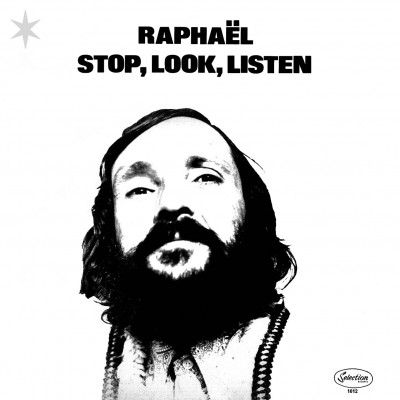Après les réeditions remarquées de Don Cherry, Doug Carn, The John Betsch Society, Heavenly Sweetness sort de l’ombre une rareté à découvrir d’urgence , l’album du pianiste Raphaël
Les discophiles acharnés qui écument quotidiennement les magasins de disques et les sites internet connaissent ce sentiment exaltant de la découverte d’un graal au hasard de leurs recherches, un disque souvent oublié ou inconnu de la communauté musicale et qui pourtant correspond parfaitement à leur paysage musical intérieur. Cette expérience quasi mystique se déploie à la première écoute du disque et à la lecture attentive de la pochette pour constituer un moment amoureux qui justifie les longues heures passées sans succès dans une quête qui les accaparent souvent au détriment de toute obligation sociale.
C’est ce rare sentiment que j’ai éprouvé en découvrant l’album de Raphael ‘stop, look , listen’ au milieu des années 90 à Paris. Quinze ans plus tard la magie de ce disque résiste encore aux nombreuses écoutes et nourrit toujours mon âme comme peu d’albums. Mais pour autant, le mystère qui entoure sa conception et son auteur, Raphael, perdure.
La session d’enregistrement de ‘Stop look listen’ se déroula le 3 juin 1972 et, si la personnalité et l’histoire du leader sont mystérieuses, ses accompagnateurs belges sont des figures de la scène bruxelloise. Le batteur Robert Pernet, le vibraphoniste et percussioniste Johnny Perret où le contrebassiste Paul Dubois jouèrent et enregistrèrent avec Toots Thielemans, Bobby Jaspar et de nombreux autres pendant une trentaine d’années. Malheureusement Paul Dubois, seul membre de la section rythmique encore en vie et qui ne joua avec le pianiste que lors de cette session n’a plus de souvenir de Raphael où de la chanteuse lyrique Rose Thompson qui illumine les arrangements de son chant lyrique.
Mais, le cœur du mystère entourant cet album, plus encore que les conditions de sa naissance, est la nature magique des compositions enregistrées. Raphael réussit au sein de chaque morceau à créer une alchimie unique, un assemblage harmonieux de styles musicaux a priori très différents, be-bop, chant lyrique, free jazz , rock. Si les tentatives de fusion furent nombreuses à cette époque, le lyrisme et la poésie de cette œuvre n’ont pas d’équivalents. Stop, look, listen …
Record lovers who spend their time trawling record shops and websites are familiar with that ecstatic feeling of stumbling accidentally upon a treasure: a record forgotten or unknown to the musical community but perfectly matched to their inner musical landscape. This near-mystical experience then further unfolds as a first listen to the album and a careful read of the liner notes combine to form a passionate moment that justifies the long hours spent in a vain and obsessive quest to the exclusion of all social obligations.
This was the rare sensation I felt on discovering Raphael’s album ‘Stop, Look, Listen’ in the mid-nineties in Paris. Fifteen years later, repeated listening has in no way diminished the record’s magic and it still nourishes my soul like few other albums do. Still, the mystery surrounding the origins of this album and its creator, Raphael, lingers on.
I was too late, unfortunately, to find the original Brussels-born producer, Pierre Pletinckx, for this re-edition. This militant jazzman, who produced a great number of albums for various different labels, passed away in the early 2000s and his widow, despite her willingness, was unable to turn up any information about the enigmatic pianist, whose sole album was ‘Stop, Look, Listen’. According to the original liner notes and the meagre details I could glean, the pianist and composer Phil Raphael was born in New York in 1930 and an active member of the capital of bop’s music scene during the 1950s, occasionally playing with Charlie Parker and saxophonist John Eardley. The only recorded trace of his activities is a session he did with the legendary trumpet player Red Rodney for the Prestige label in 1951.
According to the liner notes, Phil Raphael also played in Tommy Dorsey and Stan Kenton’s big bands – although there is no recorded proof of this – and moved to Las Vegas for a while. It is unknown exactly when he appeared on the Belgian scene, nor when he disappeared from the musical life of Brussels, but he did play at the Pol’s club where his wife worked as a cloakroom assistant during the 1970s.
The recording session for ‘Stop, Look, Listen’ took place on 3rd June 1972 and although the character and story of the leader remain a mystery, his Belgian accompanists were well-known figures on the Brussels scene. Drummer Robert Pernet, vibraphone player and percussionist Johnny Perret and double bass player Paul Dubois played and recorded with Toots Thielemans, Bobby Jaspar and many others for thirty years or so. Unfortunately, Paul Dubois, the only surviving member of the rhythm section, who played just this once with the pianist, has no memory of Raphael or of the opera singer Rose Thompson, whose voice lights up the arrangements.
However, the real mystery surrounding this album – even more than the circumstances in which it came into existence – is the magical nature of the compositions. Raphael manages to create a unique alchemy on every track, a harmonious blend of very different musical styles: be-bop, opera, free jazz, and rock. Many musicians tried their hand at fusion around that time, but this album is unequalled in its lyrical, poetic chemistry. Stop, look, listen…
